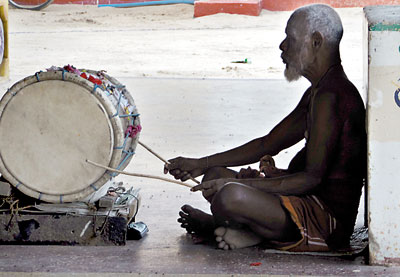Sunday Times 2
Samkathana: A fabric of Sri Lankan culture
The ritual of lighting the ‘Traditional oil lamp’ today has become customary at all State functions devoid of the religious belief of the community, although the cock bird (savula) at the top of the brass lamp, according to Hindu mythology is the symbol of the Fire God (Agni).
Brahmin families in Chunnakam (Jaffna) prepare food for Gods without salt, just like the cooks in sacred kitchen of the Soragune Katharagama Devalaya in Sabaragamuwa.
The ‘design’ of rituals keeps changing to suit the space where it is enacted and the design keeps on evolving to meet up with the requirements and values of contemporary society.
The knowhow of communities such as technologies of potters, weavers, wood carvers, dancers, drummers, singers as well as knowledge of service communities such as barbers, washer men, makers of drums or those who tan leather transcend ethnic identities of being Sinhalese, Tamil, Muslim, Burgher, Malay, Ahiguntaka, Wanniyala-Attho or any religious identity of being Buddhist, Hindu, Christian or Muslim.
All craft skill and ritual practices interweave to produce the rich fabric of Sri Lankan culture.
Some of the threads of this cultural fabric are time worn-out and fragile. Due to discrimination by other communities because they are supposed to belong to a ‘lower caste’ or because they perform tasks such as beating drums at funerals, embalming and manual scavenging, many have sought other professions. Their traditions and rituals are fast disappearing. Moving into other professions they seem to merge into ‘mainstream traditions’. Their ritual practices, designs and techniques will not be handed over to the younger generation of the 21st century.
The flip side of the coin is that crafts, weaving, dancing and drumming is taught at Art Centres (Kalayatanayas) to young people eager to learn the trade, because of lucrative employment in the tourist trade. The communities that were custodians of tradition over generations hidden in faraway villages, now have to face competition by new-comers to the trade who cater to the tastes of the urbanised Sri Lankans.
Research has shown that traditions are constantly being invented in an effort to demarcate what is known as ‘our culture’ from practices of other cultures alienated as belonging to the ‘others’. Samkathana, the HETC (Higher Education for Twenty-first Century) project at the Faculty of Humanities, University of Kelaniya is designed to collect and document data of communities who have been under-represented in mainstream ethnographic research. Researchers are engaged in collecting linguistic data of ‘Discourse Communities’ and disseminate the knowledge in main stream media, and document the rich fabric of Sri Lankan culture.
At Samkathana, the Festival of Discourse Communities, the audience will be seated on mats and witness how the auditorium of the Senake Bandaranayake Hall (K 30) will be transformed into a ritual space bringing to life highlights of
Kohombakankariya, Pahan Maduwa and Bali Shanti Karmaya, performed by members of the ritual communities.
Samkathana, the exhibition of Ritual Design will showcase altars of the three rituals: The Ailaya for Kohombakankariya from the Udarata Sampradaya (Kandyan Tradition), Ailaya for Pahan Maduwa from the Sabaragamuwa Tradition, Bali Yak Pola from the Bali Ritual from the Pahatarata Sampradaya , performed to evoke Planetary Gods will be built according to practices of the communities, who will be performing chosen excerpts of the ritual lasting about two hours in total. The festival is curated by Prof. Asoka de Zoysa, University of Kelaniya.

